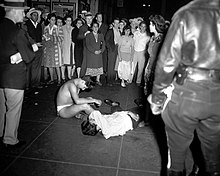
Back Zoot Suit Riots German Disturbios del Zoot Suit Spanish Zoot Suit Riots French מהומות חליפות הזוט HE Zoot Suit Riots Dutch Zoot Suit-opptøyene NB Zoot Suit Riots SIMPLE
| Zoot Suit Riots | |
|---|---|
 Boys stripped and beaten by U.S. Navy sailors | |
| Location | Los Angeles, California, United States |
| Date | June 3–8, 1943 |
| Target | Mexican American youths and other zoot suit wearers |
| Injured | 150+ |
| Victims | 500+ arrested |
| Perpetrators | American servicemen, police officers, and white civilians |
| Motive | Racism, removal of zoot suits and "hoodlums" |
| Part of a series on |
| Discrimination |
|---|
 |
| This article is part of a series on the |
| History of Chicanos and Mexican Americans |
|---|
The Zoot Suit Riots were a series of riots[1] that took place from June 3–8, 1943, in Los Angeles, California, United States, involving American servicemen stationed in Southern California and young Latino and Mexican American city residents.[2] It was one of the dozen wartime industrial cities that suffered race-related riots in the summer of 1943, along with Mobile, Alabama; Beaumont, Texas; Detroit, Michigan; and New York City.
American servicemen and white Angelenos attacked and stripped children, teenagers, and youths who wore zoot suits, ostensibly because they considered the outfits, which were made from large amounts of fabric, to be unpatriotic during World War II. Rationing of fabrics and certain foods was required at the time for the war effort. While most of the violence was directed toward Mexican American youth, African American and Filipino American youths who were wearing zoot suits were also attacked.[3]
The Zoot Suit Riots were related to fears and hostilities aroused by the coverage of the Sleepy Lagoon murder trial, following the killing of a young Latino man in what was then an unincorporated commercial area near Los Angeles. The riot appeared to trigger similar attacks that year against Latinos in Chicago, San Diego, Oakland, Evansville, Philadelphia, and New York City.[4] The defiance of zoot suiters became inspirational for Chicanos during the Chicano Movement.[5][6][7]
- ^ Pagan, Eduardo Obregon (2000). "Los Angeles Geopolitics and the Zoot Suit Riot, 1943". Social Science History. 24 (1): 223–256. doi:10.1017/S0145553200010129. ISSN 1527-8034. S2CID 145233558.
- ^ "Zoot Suits Riots". August 9, 2023.
- ^ Peiss, Kathy (2011). Zoot Suit. University of Pennsylvania Press. p. 33. ISBN 9780812223033.
Over the next few days, crowds of white civilians joined in the rampage, targeting mainly Mexican American youths but also some African Americans and Filipinos.
- ^ Novas, Himilce (2007). "Mexican Americans". Everything you need to know about Latino history (2008 ed.). New York City: Plume. p. 98. ISBN 9780452288898. LCCN 2007032941.
- ^ Sandoval, Denise M. (2013). "The Politics of Low and Slow/Bajito y Suavecito: Black and Chicano Lowriders in Los Angeles, from the 1960s through the 1970s". In Kun, Josh; Pulido, Laura (eds.). Black and Brown in Los Angeles: Beyond Conflict and Coalition. Berkeley, California: University of California Press. p. 197. ISBN 9780520956872.
- ^ Mazón, Mauricio (1989). The Zoot-Suit Riots: The Psychology of Symbolic Annihilation. University of Texas Press. pp. 118. ISBN 9780292798038.
- ^ Berumen, Garcia; Javier, Frank (2016). Latino Image Makers in Hollywood: Performers, Filmmakers and Films Since the 1960s. Jefferson, North Carolina: McFarland. p. 145. ISBN 9781476614113.
© MMXXIII Rich X Search. We shall prevail. All rights reserved. Rich X Search